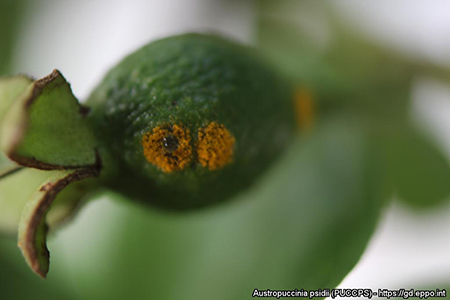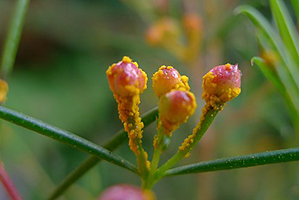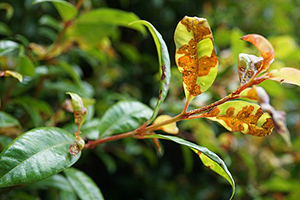
EPPO Alert List – Austropuccinia psidii
Myrtle rust
Why
Austropuccinia psidii, causing myrtle rust, was added to the EPPO Alert List (as Puccinia psidii) in 1998 and removed in 2003 as a Pest Risk Analysis concluded that the risk was low for the EPPO region. However, since then, the fungus has established in areas with a climate more similar to the climate of the EPPO region, significantly increased its host range, and recent interceptions indicate that it can move in trade with plants for planting. In addition, new aggressive races of A. psidii have been observed. The Panel on Phytosanitary Measures considered that it should be added again to the Alert List to raise awareness among NPPOs.

Courtesy Regina Sugayama
On Psidium guajava fruit (in Brazil)
Where
A. psidii is considered to be native from South America.
EPPO region: Portugal, Switzerland.
Africa: South Africa.
Asia: China (Guangdong, Hainan), Indonesia (Java, Sumatra), Japan, Singapore, Taiwan.
North America: Mexico, United States of America (California, Florida, Hawaii).
Central America and Caribbean: Costa Rica, Cuba, Dominica, Dominican Republic, Guatemala, Jamaica, Panama, Puerto Rico, Trinidad and Tobago, Virgin Islands (British), Virgin Islands (US).
South America: Argentina, Brazil (Amapa, Bahia, Espirito Santo, Minas Gerais, Para, Parana, Pernambuco, Rio de Janeiro, Rio Grande do Sul, Santa Catarina, Sao Paulo), Colombia, Ecuador, Paraguay, Uruguay, Venezuela.
Oceania: Australia (New South Wales, Northern Territory, Queensland, Tasmania, Victoria), New Caledonia, New Zealand.
On which plants
A. psidii infects over 500 species in the Myrtaceae family. This includes numerous native species in Oceania, as well as commercially important species for wood production (e.g. Eucalyptus spp.), for fruit production (e.g. Acca sellowiana, Psidium guava) or as ornamentals (e.g. Callistemon, Eugenia, Melaleuca, Syzygium). Myrtus communis, the sole Myrtaceae species native to Europe, and an important component of vegetation in Mediterranean regions, was recently shown to be a host.
Damage
A. psidii infects young leaves, shoot tips and young stems. Fruit and flower parts are also susceptible. The first signs of rust infection are tiny spots or pustules which then evolve to form distinctive yellow pustules. The disease can cause deformed leaves, heavy defoliation of branches, dieback, stunted growth and even plant death.
Dissemination
Urediniospores of A. psidii can be wind-dispersed over long distances. Spores can also be dispersed by animals (e.g. birds, bats, insects). Viable spores have been detected on clothing, personal effects, and equipment following visits to rust-affected plantations. In trade, infected plants for planting are considered as a pathway of introduction into new areas. The potential introduction with wood is not clear.
Pathways
Plants for planting, cut foliage, wood?
Possible risks
A. psidii has caused significant impacts in Eucalyptus plantations in Brazil and in natural ecosystems in Oceania. Once introduced into an area, it has proved impossible to eradicate. In the EPPO region, hosts plants are grown for wood and ornamental purposes, and M. communis is an important species in Mediterranean ecosystems. There is uncertainty on the climatic suitability of the whole EPPO region for the establishment of the fungus but it seems advisable to prevent its introduction.
Sources
Almeida RF, Machado PS, Damacena MB, Santos SA, Guimarães LM, Klopfenstein NB, Alfenas AC (2021) A new, highly aggressive race of Austropuccinia psidii infects a widely planted, myrtle rust‐resistant, eucalypt genotype in Brazil. Forest Pathology 51(2), e12679.
Beenken L (2017) Austropuccinia: a new genus name for the myrtle rust Puccinia psidii placed within the redefined family Sphaerophragmiaceae (Pucciniales). Phytotaxa 297(1), 53-61.
Berthon K, Esperon-Rodriguez M, Beaumont LJ, Carnegie AJ, Leishman MR (2018) Assessment and prioritisation of plant species at risk from myrtle rust (Austropuccinia psidii) under current and future climates in Australia. Biological Conservation 218, 154-162.
Boufleur TR, Morales JV, Martins TV, Gonçalves MP, Júnior NS, Amorim L (2023) A diagnostic guide for myrtle rust. Plant Health Progress 24(2), 242-251. https://doi.org/10.1016/j.biocon.2017.11.035
CABI datasheet (2014) Austropuccinia psidii (myrtle rust) https://doi.org/10.1079/cabicompendium.45846
Carnegie AJ, Pegg GS (2018) Lessons from the incursion of myrtle rust in Australia. Annual Review of Phytopathology 56(1), 457–478. https://doi.org/10.1146/annurev-phyto-080516-035256
Liu F, Liu Q, Li G (2024) Myrtle rust, a serious threat to horticultural plant Rhodomyrtus tomentosa (Myrtaceae) in southern China. Physiological and Molecular Plant Pathology 130, 102243. https://doi.org/10.1016/j.pmpp.2024.102243
Kriticos DJ, Morin L, Leriche A, Anderson RC, Caley P (2013) Combining a climatic niche model of an invasive fungus with its host species distributions to identify risks to natural assets: Puccinia psidii sensu lato in Australia. PLoS One 8(5), e64479. https://doi.org/10.1371/journal.pone.0064479
Narouei‐Khandan HA, Worner SP, Viljanen SL, Van Bruggen AH, Jones EE (2020) Projecting the suitability of global and local habitats for myrtle rust (Austropuccinia psidii) using model consensus. Plant Pathology 69(1), 17-27. https://doi.org/10.1111/ppa.13111
NVWA (2024) Quick scan for Austropuccinia psidii. https://pra.eppo.int/pra/ae7a38d5-c675-47e1-8bbf-8d8972dcd0a4
NPPO of Portugal (2025-07).
Paap T, Santini A, Rodas CA, Granados GM, Pecori F, Wingfield MJ (2023) Myrtus communis in Europe threatened by the pandemic and South African strains of the myrtle rust pathogen Austropuccinia psidii (Sphaerophragmiaceae, Pucciniales). NeoBiota 84, 41-46. https://doi.org/10.3897/neobiota.84.95823
Ramos AP, Garcia C, Melo I, Maia F, Soares AL, Talhinhas P (2025) First report of Austropuccinia psidii causing myrtle rust on outdoor Myrtaceae in Europe. Plant Disease (early view) https://doi.org/10.1094/PDIS-07-25-1433-PDN
Ruffner B, Beenken L, Kupper Q, Mittelstrass J, Schuler P, Stewart JE, Caballero JI, Winiger R, Prospero S (2024) First report of Austropuccinia psidii on Syzygium buxifolium grown as indoor bonsai in Europe. New Disease Reports 50 (2), e70011. https://doi.org/10.1002/ndr2.70011
Soewarto J, Giblin F, Carnegie AJ (2019) Austropuccinia psidii (myrtle rust) global host list. Version 2. Australian Network for Plant Conservation, Canberra, ACT. http://www.anpc.asn.au/myrtle-rust
Soewarto J, Somchit C, Du Plessis E, Barnes I, Granados GM, Wingfield MJ, Shuey L, Bartlett M, Fraser S, Scott P, Miller E (2021) Susceptibility of native New Zealand Myrtaceae to the South African strain of Austropuccinia psidii: A biosecurity threat. Plant Pathology 70(3), 667-675. https://doi.org/10.1111/ppa.13321
Yeh Y-H, Kirschner R (2025) Outbreak of the myrtle rust Austropuccinia psidii on Myrtaceae in Taiwan. Fungal Science 40(1), 1–8
EPPO RS 1998/199, 1999/134, 2003/041, 2014/150, 2023/194, 2024/049, 2024/212, 2024/228, 2025/041, RS 2025/197, RS 2025/198


